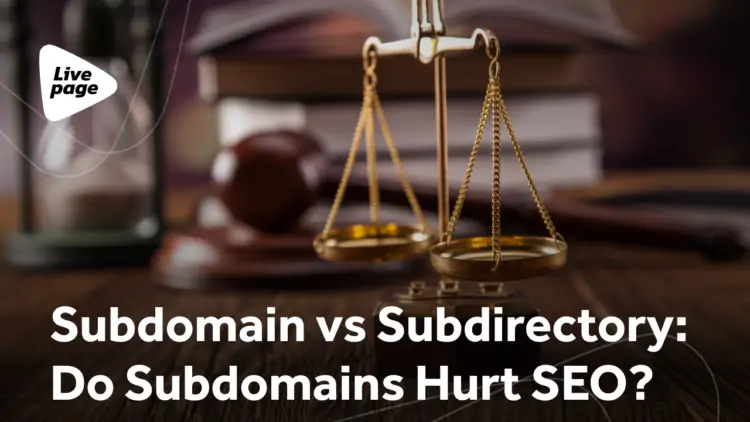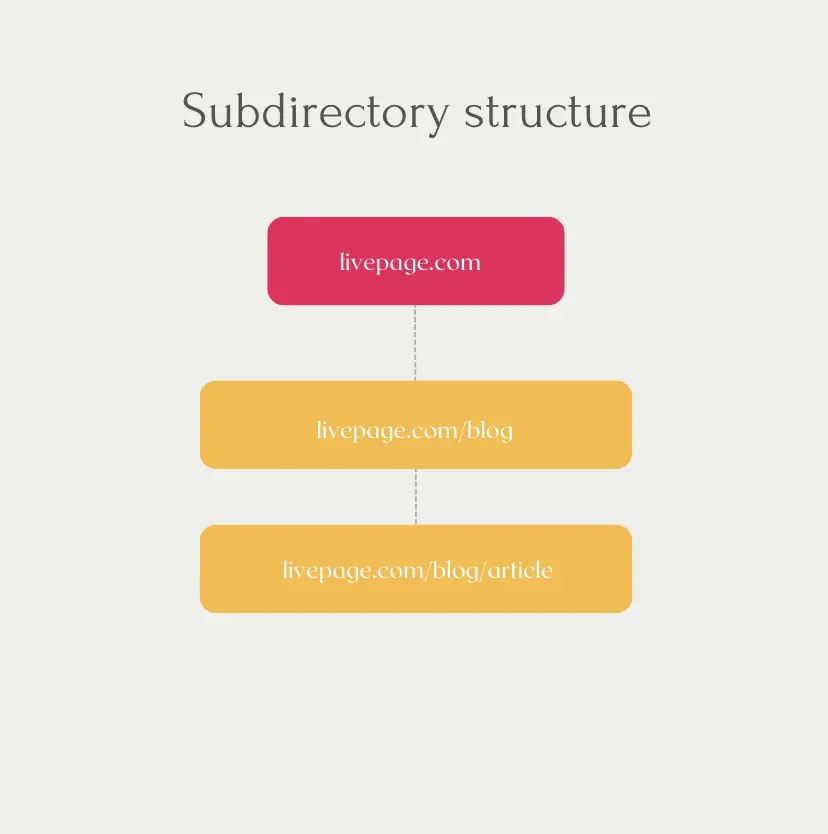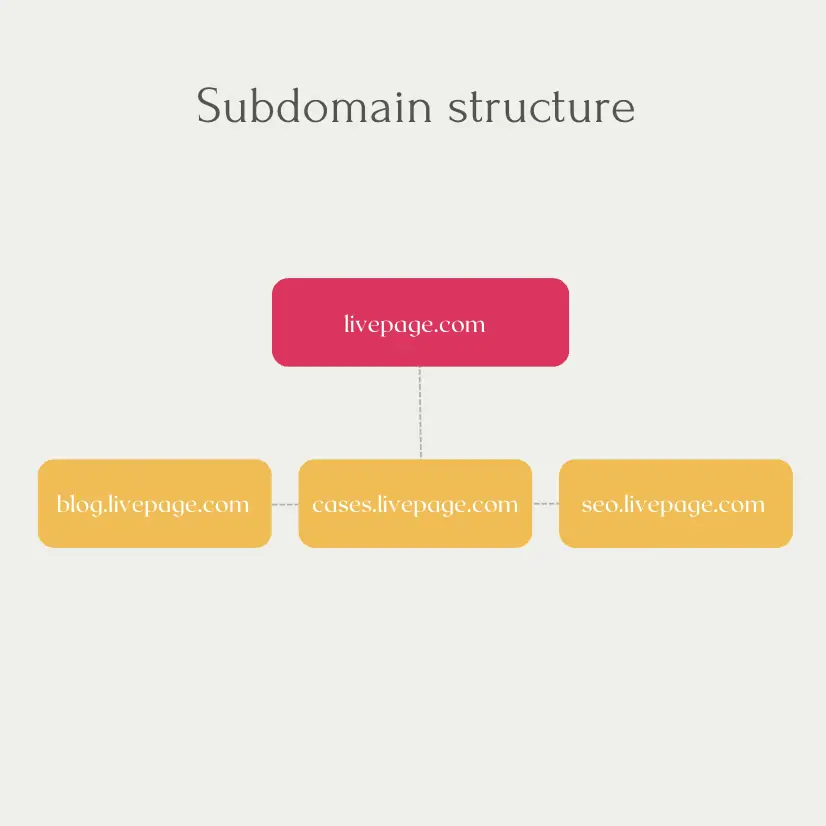
Subdomain vs Subdirectory: Do Subdomains Hurt SEO?

The debate about whether subdirectories vs subdomains are better has been going on in the professional SEO community for many years. There are many opinions about how Google ranks them: some say that the search engine likes subdomains more, and some say it prefers subdirectories.
Whether you choose a subdomain vs a subdirectory for new language versions of your website, when you need to create a blog for e-commerce, or when you develop local projects, you should know all the intricacies of your options.
In this article, we will dispel myths about subdomains and subdirectories, understand what Google prefers, and look at our cases.
What is a Subdirectory?
Subdirectory is a way to organize the site hierarchy by adding a folder. A subdirectory is any category placed in the site’s URL with a slash “/”.For example, when you go to our website’s blog, you are taken to the /blog subdirectory: https://livepage.ua/blog/.

Each subsequent section will add a new subdirectory to the URL, thereby adding new levels of nesting and worsening the link indexing (as you know, the more levels of nesting a link has, the less likely Googlebot will find and index it).
Why to Use Subdirectories? 4 Reasons to Consider
When comparing a subdomain vs a subdirectory in SEO, the latter is a very convenient way to organize website content with a significant advantage over a subdomain. Google perceives subdirectories as part of the main site.
Simplicity
In practice, maintaining and managing a site with subdirectories is much easier than managing several different resources.
Intuitive URL structure
Proper URLs with subdirectories are much better perceived by search engines and users who better understand the relationships between categories and subcategories. For example, when users click on a blog category, they are redirected to the URL: https://site.com/blog. Then they click on an article and go down one level deeper: https://site.com/blog/article. Thanks to the clear URL structure, the user understands where they are and how they got to this particular place.
However, this only works if the link structure is really clear. If we add a lot of subdirectories to a link, it will become more and more confusing for the user with each level of nesting. For example, in this version: https://site.com/0001/blog/30582/article, 0001 is the category number in the site’s admin panel, and 30582 is the article number. Sometimes, such URLs are a feature of a poorly made custom-coded CMS system.
Proper internal weight distribution
When all site categories are placed in subdirectories, they are linked via manual and automatic linking. Thus, the site breadcrumbs help to transfer weight from all the “lower” pages to the “upper” more important ones. This evenly distributes the link juice among all pages, improving their indexing and ranking.
Better behavioral factors
Since all the information is concentrated on one domain, users do not go beyond it, increasing the time spent and the browsing depth.
What is a Subdomain?
A subdomain is a prefix attached to a domain name and allows you to create separate sites within the main one.
Let’s go back to the example with our blog. If the Livepage blog was located on a separate subdomain, the URL would look like this: https://blog.livepage.ua.

The prefix added to a domain is always placed before it.
Why Use a Subdomain
Subdomains are often used when a website has a lot of content that is difficult to manage in one place or when various campaigns/integrations with other businesses are launched that need to be separated from the main website.
For branch offices
For websites of branch offices of one company in different countries within the same language version/different language versions, subdomains allow you to:
- use different contacts;
- add a different team;
- focus on different products and services;
- add different documentation (PDF files with commercial offers, product presentations, etc.).
For brands
When a company produces several brands, subdomains provide an opportunity to implement different tasks:
- positioning;
- color scheme;
- pricing policy.
And you can also focus on a different target audience.
For additional categories
Subdomains can be used to connect additional services or information sections to the main website and business, for example, when an online store is attached to a forum for buyers or when an IT business website is attached to a forum for developers. A blog with informative content and articles should not be placed on a subdomain.
Differences Between Subdomains and Subdirectories
Here is what you need to consider when to use a subdomain vs a subdirectory:
- hierarchical structure;
- URL structure;
- indexing;
- ranking.
Let’s review each of them in more detail.
Site hierarchy
While creating subdirectories is essentially a vertical hierarchy, subdomains have a horizontal hierarchy.
Subdirectory structure

Subdomain structure

URL structure
Subdirectories are placed after the domain:
https://site.com/subdirectory/
While subdomains are always placed before it:
https://subdomain.site.com/
Indexing
Each level of nesting, or depth level, worsens the URL indexing. The more subdirectories are in the link, the less value each new level will have for Google. The third level of nesting is considered normal. All subdirectories that follow it will be indexed worse. It is also less likely that the crawler will ever reach it.
Ranking
The main difference between a subdomain and a subdirectory is that when you create a subdomain, you get a separate website with a new topic and authority. Yeah, that’s how Google works.
When you create a new website, you need to work from scratch on the subject matter, gaining authority, expertise, and trust from search engines.
Everything is much easier with subdirectories because you essentially make a folder within the existing site where you place the category. This way, the category receives the entire arsenal of previously earned benefits (through content and links), which helps it rank better.
Subdomain vs Subdirectory: Which One to Choose?
Pros and cons of a subdomain vs a subdirectory differ, but they have their share of both. Google allows you to choose any of these options because you will not get penalties for placing your blog in a subdirectory or subdomain.
If your site has a complex structure, and adding a new section will only complicate it or not match your brand’s main product/tone of voice, it makes sense to consider using a subdomain.
If you choose a subdirectory vs a subdomain for a store blog, a new language, etc., we recommend using the first option. Firstly, promoting the created category in the search results will be easier. Secondly, optimizing such a category will positively affect the entire site.
| Subdomain | Subdirectory | |
| Improving behavioral factors | ❌ | ✅ |
| Simple management | ❌ | ✅ |
| Correct distribution of internal link juice | ❌ | ✅ |
| Correct distribution of external link juice | ❌ | ✅ |
| Clear structure | ✅ | ✅ |
| Access to different designs | ✅ | ❌ |
| Emphasis on different target audiences | ✅ | ❌ |
Subdomain vs Subfolder: How Does It Work in Reality?
Our company had a positive experience of moving a client’s blog from a subdomain to a subdirectory, which clearly showed that Google ranks it better despite its claims that both options are equal.
Our client, a large IT company, had a blog on a subdomain and all services on the main domain. We decided to move the blog to a subdirectory to improve the ranking process.
After 2.5 months, we evaluated the results:



Transferring the blog from a subdomain to a subdirectory had a significant impact on the positions of news articles:
- 108% increase in the number of keywords at the TOP-1 of organic search;
- 79% increase in the number of keywords in the TOP-3.
Since the blog was transferred from a subdomain to a subdirectory, the number of our client’s pages at the TOP-10 of Google search results has increased by 348 keywords.
As you can see, the traffic and rankings of the site have grown significantly, which clearly shows us that subdirectories are the best way to place additional sections on the site in most cases.
Conclusion
Summarizing the above, it is worth saying that each option, both subdomain and subdirectory, has the right to exist. And it is always up to you to decide when choosing a subdomain vs subdirectory.
If it is important for you to distinguish:
- design,
- target audience,
- contacts,
- individual company resources,
Then, you should consider using subdomains.
If you are interested in:
- convenient structure,
- behavioral factors,
- correct distribution of both external and internal link juice,
We recommend paying attention to subdirectories.
If you are unsure which solution to choose for your business, contact Livepage. We will help you develop the right website structure or restructure your website to a subdomain or a subdirectory without losing traffic and positions.



















